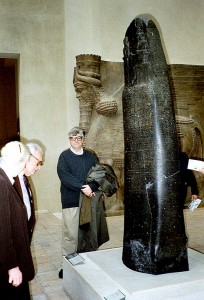(Texts: All Artifacts, Color Coding, & Writings in Bold Type With Italics Inside Parenthesis, are Added by Editor R. Brown, not the Authors, Translators, or Publishers!)
(gods in blue …mixed-breed demigods in teal…)
ETEMENANKI: ZIKKURAT BABIBLI: CAPTION IDENTIFYING THE GREAT ZIGGURAT OF BABYLON, THE TOWER OF BABEL. THE ROYAL INSCRIPTION OF NEBUCHADNEZZAR CONTINUES:
THE HOUSE, THE FOUNDATION OF HEAVEN AND EARTH,
ZIGGURAT IN BABYLON. ETEMENANKI (Marduk’s temple / residence in Babylon),
I MADE IT THE WONDER OF THE PEOPLE OF THE WORLD,
I RAISED ITS TOP TO THE HEAVEN,
MADE DOORS FOR THE GATES,
AND I COVERED IT WITH BITUMEN AND BRICKS

(Nebuchanesser II stele with faint Tower of Babel in front of him, & his inscription)
MS in Neo Babylonian on black stone, Babylon, 604-562 BC, the upper half of a stele with rounded top, 47x25x11 cm, originally ca. 80-100x25x11 cm, 3+24 lines in cuneiform script, to the left: carving of the Tower of Babel from a side view, clearly showing the relative proportions of the 7 steps and the buttress construction and a temple complex at its foot; to the right: the standing figure of Nebuchadnezzar II with his royal conical hat, holding a spear in his left hand and a scroll with the rebuilding plans of the Tower in his outstretched right hand; at the top: a line drawing of the ground plan of the temple on the top, showing both the outer walls and the inner arrangement of rooms, including the one that once had a fine large coach in it, richly covered, and a gold table beside it, according to Herodot: The Histories I:181; on the left edge: a line drawing of the ground plan of Esagila, the temple of Marduk, showing the buttresses as an integral part of the construction.
Context: The lower part of the stele with account of further building works on other temples, was in a religious institution in U.S.A. The stele was found in a special hiding chamber, broken into 3 parts in antiquity, at Robert Koldewey’s excavations of the site of the Tower of Babel in 1917. Its importance was immediately recognized. A photograph was taken with 3 archaeologists standing next to the stele. With the imminent danger of war breaking out in the area, they decided to rescue it, and each archaeologist carried one part out of the war zone. Two parts were taken to Germany, the third part to U.S.A. Now the 2 most important parts are reunited in The Schøyen collection. For bricks from the Tower of Babel, stamped with Nebuchadnezzar’s name, used during the rebuilding, see MS 1815/1-3. For the only other known architect’s plan of a known temple, see MS 3031.
Commentary: The Ziggurat in Babylon was restored and enlarged by Nebuchadnezzar II, King of Babylon 604-562, captured by Kyros (Cyrus) 538 BC, Dareios I 519 BC, Xerxes ca. 483 BC, (kings protected by Ashur) and entirely destroyed by Alexander I the Great 331 BC. (with Enlil’s protection) Until now our knowledge of the Tower of Babel has been based on the account in Genesis 11:1-9, and of Herodot: The Histories I:178 – 182, with the measurement of the first 2 steps, and a Seleucid tablet of 229 BC (Louvre AO 6555), giving the sizes of the steps.
However, no contemporary illustrations have been known, resulting in a long series of fanciful paintings throughout the art history until present. Here we have for the first time an illustration contemporary with Nebuchadnezzar II’s restoring and enlargement of the Tower of Babel, and with a caption making the identity absolutely sure. We also have the building plans, as well as a short account of the reconstruction process. Only 4 of 24 lines concerning this has so far been read.
The last of these lines also covers the restoration of the E-ir-inimanki ziggurat in Borsippa, once believed by some scholars to be the Tower of Babel. A German scholar identified a few worn wedges to represent the name of Nebuchadnezzar II; and Dr. Stefan Maul has recently confirmed the reading.

